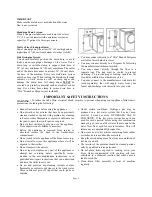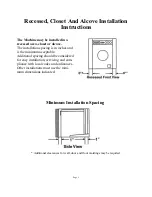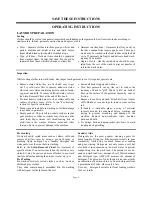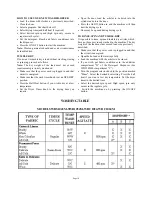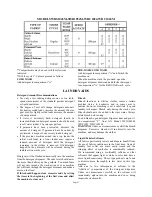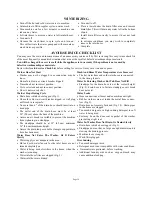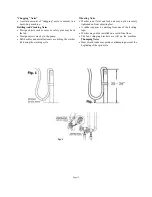
Nail Polish
Treat while fresh, scraping or wiping off as much as
possible, before it dries. Place stain face down on white
paper towels. Sponge back of stain acetone (nail polish
remover) or sponge with denatured alcohol and a few
drops of household ammonia. Sponge stain frequently.
Launder with water at temperature suitable for fabric.
Note: Do not use acetone on acetate, arnel, dynel or
rayon.
Paint
Sponge or soak in turpentine or solvent recommended as
a thinner on label. Launder.
Perfume
Rinse in cold water. Rub undiluted liquid detergent or a
detergent paste into stain. Rinse. If stain remains, bleach.
Perspiration
Wash or sponge stain thoroughly with warm water and
detergent paste. If perspiration has changed the color of
the fabric, restore it by treating with ammonia or vinegar.
Apply ammonia to fresh stains; rinse with water. Apply
vinegar to old stains; rinse with water.
Rust and Iron
Apply commercial rust remover, according to manufac-
turer's directions. Rinse. Or, if safe for fabric, boil stained
article in solution of 4 teaspoons of cream of tartar to 1
pint water.
Scorch
Rinse or soak in cold water. Work detergent into stain.
Rinse. Bleach, if necessary. Stain may be impossible to
remove.
Shoe Polish
Scrape off as much as possible. Pre-treat with a detergent
paste; rinse. If stain persists, sponge with rubbing alcohol
(1 part to 2 parts water) or turpentine. Remove turpentine
by sponging again with warm detergent solution or with
alcohol. Bleach if necessary.
Soft Drinks
Sponge with cold water, some stains are invisible when
they have dried, but turn brown when heated and may be
impossible to remove.
Tar and Asphalt
Act quickly before stain is dry. Sponge with grease
solvent or turpentine. Launder.
Urine
Soak in cool water. If stain is dry, work a detergent paste
into the spot then rinse. If necessary, bleach.
Page 13
CARE AND CLEANING
Cleaning The Exterior
As you use the washer, occasionally wipe the cabinet
with a damp cloth or sponge; wipe dry with a soft cloth.
Do not use polish or any kind on the plastic trim. Some
polishes contain agents which may damage plastics.
Cleaning The Interior
If you live an area where phosphate detergents are
banned, it may be necessary to recondition the washer
periodically. Because a non-phosphate detergent must be
used, body oils and detergent may accumulate in the
washer tub. This is particularly evident in hard water
areas or in homes, where heavily soiled garments are
regularly laundered.
To remove this build-up, run the washer through a
complete cycle using hot water and 2 cups of a non
precipitating water conditioner. Do not add any clothes,
laundry detergent or other laundry aids.
Once all accumulation has been removed, your laundry
should be satisfactory if you follow the preventive
suggestions in this guide-book.
General Maintenance
After washing is complete, the water faucets should be
turned off to relieve water pressure on the hoses.
Wipe the inside of the washer door with a soft cloth to
remove any remaining moisture. Periodically, a thin coat
of paste wax should be applied to the inner door of the
washer; especially to the area which is immediately next
to the door window.
This will protect the door finish from laundry aid spills
and any discoloration which may results from these
spills.
The interior of the machine should be cleaned periodi-
cally by qualified service personnel.
A internal condenser cleaning kit is available to improve
drying time when needed (Part # 100A).
Cleaning The Drain Screen
Clean the drain screen frequently. For instruction please
refer to page 7 of this manual.
Содержание WDC1024M
Страница 10: ...Page 8 ...






